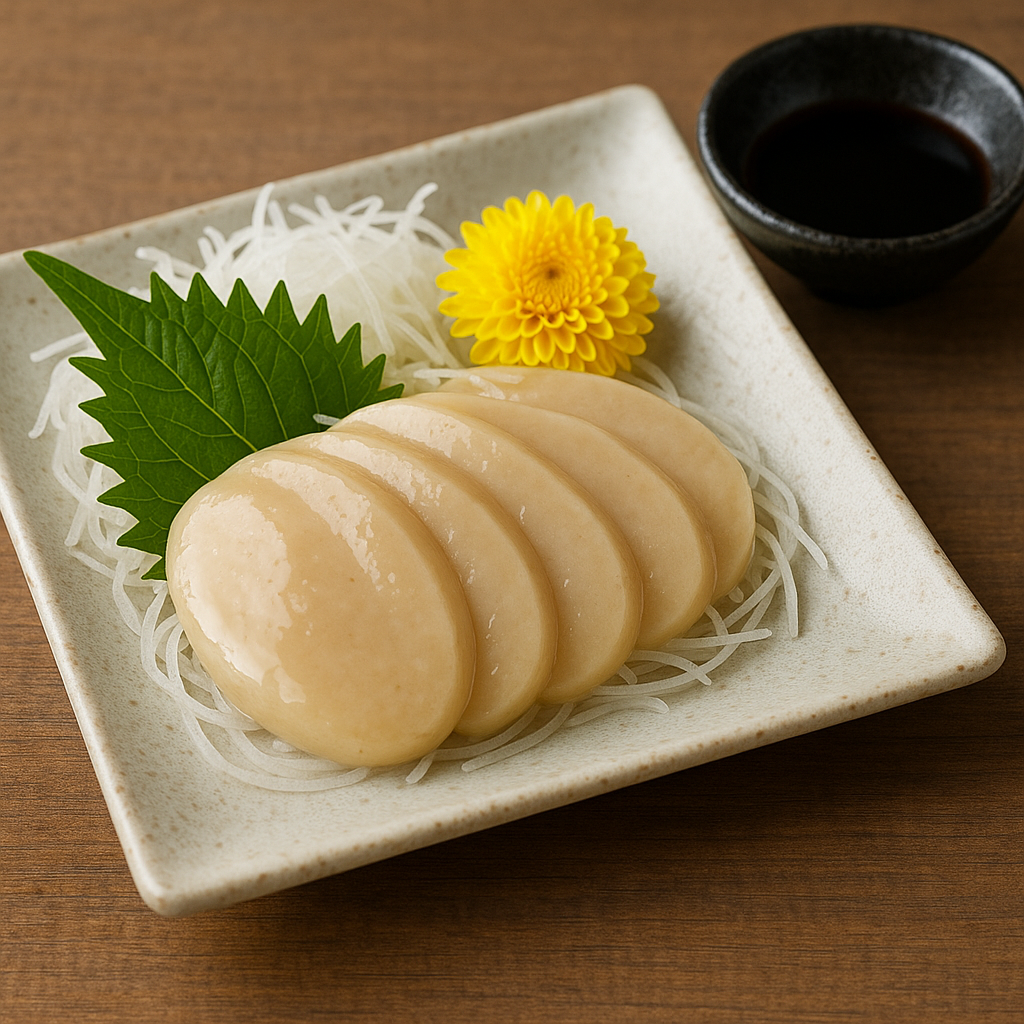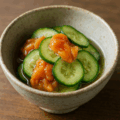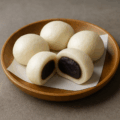くるみ豆腐(岩手)の特徴
くるみの香ばしさとなめらか食感を楽しむ、葛(または片栗)仕立て
くるみ豆腐は、炒ってすり潰したくるみに葛粉(または片栗粉)と水(またはだし)を合わせ、弱火で練り上げて冷やし固める郷土の一品です。もちっとなめらかな口当たりに、くるみのコクが広がります。
行事のお膳から日常の“お茶うけ”まで、たれで表情が変わります
甘めのくるみ蜜やだし醤油、みそだれなど、添えるたれ次第で甘味にも前菜にもなります。季節の青みをあしらうと、見た目も涼やかに仕上がります。
くるみ豆腐(岩手) レシピ
材料(5人分・流し缶1台〈約15×10cm〉)
- くるみ(むき身・軽く炒る) … 100g
- 片栗粉 … 60g
- 水 … 500ml
- 砂糖 … 20〜40g(好みで)
- 塩 … ひとつまみ
- (たれA:だし醤油)だし … 80ml/しょうゆ … 小さじ2/みりん … 小さじ1
- (たれB:くるみだれ)くるみ … 30g/砂糖 … 大さじ1〜2/しょうゆ … 小さじ1/水 … 大さじ1〜2
作り方
- くるみをすり鉢でペースト状にする(フードプロセッサー可)。
- 鍋にくず粉・水(またはだし)を入れてよく溶かし、砂糖・塩、1のくるみを加えて混ぜる。
- 弱火〜中弱火にかけ、絶えず木べらで練る。透明感が出てつやが増し、重さがつくまで8〜12分ほど練り上げる。
- 流し缶(内側を水でぬらす)に流し入れ、表面をならして粗熱を取る。冷蔵で1〜2時間しっかり冷やし固める。
- 型から外して食べやすく切り、好みのたれ(AまたはB)と薬味を添える。
- たれAは混ぜてひと煮立ち、たれBはくるみをすり砂糖・しょうゆ・水でのばして作る。
シェフのワンポイントアドバイス
- 火にかける前にでんぷんを完全に溶かすとダマになりにくいです。
- 練りは絶えず底をこそげるように。透明感とつや、もったり重さが出たら仕上がりの合図です。
- 甘味に寄せるなら砂糖をやや多め+たれB、前菜なら砂糖控えめ+たれAがおすすめです。
栄養価(1人分の目安)
- エネルギー … 180〜260 kcal
- たんぱく質 … 4〜6 g(くるみ由来)
- 脂質 … 12〜18 g(くるみ由来)
- 炭水化物 … 15〜25 g
- 食物繊維・ビタミンE … くるみ由来
歴史
精進料理の“〇〇豆腐”の系譜に連なる一品です
胡麻豆腐の技法にならい、地域の木の実であるくるみを用いて“豆腐”に見立てた料理が広がりました。葛や片栗でなめらかに固める製法が受け継がれています。
木の実文化が残る山里で親しまれてきました
くるみは保存性と栄養に優れ、行事のお膳やもてなし、小さな甘味としても重宝されてきました。たれの違いで季節や場面に合わせやすいのも魅力です。
English Version
Features of Walnut “Tofu” (Iwate)
Nutty aroma with a silky, custard-like set using potato starch (or kudzu)
Walnut “tofu” blends toasted, ground walnuts with potato starch (or kudzu) and water (or dashi), then slowly cooks the mixture until thick before chilling to set. The result is gently bouncy and smooth, with walnut richness throughout.
From ceremonial trays to everyday tea snacks—toppings change the character
Serve with sweet walnut syrup, light dashi–soy, or miso glaze to swing it toward dessert or appetizer. A touch of seasonal greens gives a cool, refined look.
Walnut “Tofu” (Iwate) – Recipe
Ingredients (Serves 5; 1 loaf pan ~15×10 cm)
- Walnuts (shelled, lightly toasted) … 100 g
- Potato starch … 60 g
- Water … 500 ml
- Sugar … 20–40 g (to taste)
- Salt … a pinch
- (Sauce A: Dashi–soy) Dashi … 80 ml / Soy sauce … 2 tsp / Mirin … 1 tsp
- (Sauce B: Walnut sauce) Walnuts … 30 g / Sugar … 1–2 Tbsp / Soy sauce … 1 tsp / Water … 1–2 Tbsp
Directions
- Grind the walnuts in a mortar to a smooth paste (or use a processor).
- In a pot, fully dissolve the potato starch in the water, then mix in sugar, salt, and the walnut paste.
- Cook over low–medium-low heat, stirring constantly with a spatula, scraping the bottom. Continue 8–12 minutes until glossy, translucent, and thick.
- Pour into a rinsed loaf pan, level the surface, and let cool. Chill 1–2 hours until set.
- Unmold, cut into portions, and serve with Sauce A or B and preferred condiments.
- For Sauce A, combine and bring just to a simmer. For Sauce B, grind walnuts and thin with sugar, soy, and water.
Chef’s Tips
- Completely dissolve the starch before heating to avoid lumps.
- Stir continuously, scraping the bottom. Gloss, slight translucence, and a heavy pull signal it’s ready.
- Sweeter profile + Sauce B for dessert; lighter sugar + Sauce A for a savory starter.
Nutrition (per serving, approx.)
- Energy … 180–260 kcal
- Protein … 4–6 g (from walnuts)
- Fat … 12–18 g (from walnuts)
- Carbohydrates … 15–25 g
- Dietary fiber & vitamin E … from walnuts
History
In the lineage of temple-style “___-tofu” dishes
Inspired by sesame tofu techniques, local walnuts substitute the seed, with starch (kudzu or potato) giving a smooth set—an approach passed down through temple and regional cooking.
A mountain-village favorite rooted in nut traditions
Valued for nutrition and keeping quality, walnuts made this dish a staple for ceremonial trays, hospitality, and small sweets. Flexible sauces keep it season- and occasion-friendly.



何でも質問してください!